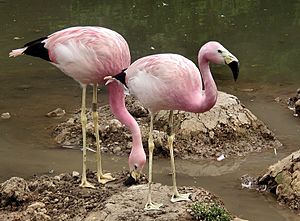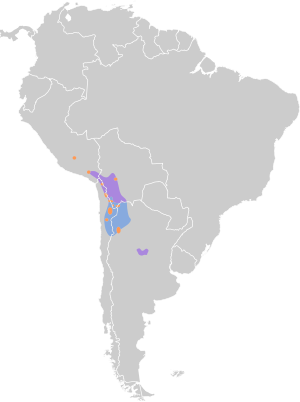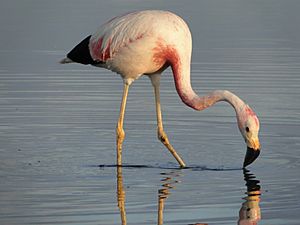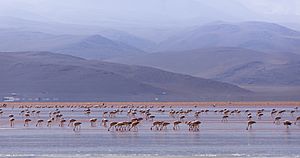Andean flamingo facts for kids
Quick facts for kids Andean flamingo |
|
|---|---|
 |
|
| Conservation status | |
| Scientific classification | |
| Genus: |
Phoenicoparrus
|
| Species: |
andinus
|
 |
|
| Synonyms | |
|
|
The Andean flamingo (Phoenicoparrus andinus) is a type of flamingo that lives in the Andes mountains of South America. Before 2014, it was part of a different group of flamingos. It is very similar to the James's flamingo. These two flamingos belong to the same group, Phoenicoparrus. The Chilean flamingo, Andean flamingo, and James's flamingo all live in the same areas. They also share colonies and nesting spots.
Contents
Description
The Andean flamingo is special because of its deep lower beak and long filters inside its upper beak. It is the biggest flamingo in the Andes. It is also one of the two heaviest living flamingos, along with the taller greater flamingo. Andean flamingos can weigh from about 1.5 to 4.9 kilograms (3.3 to 10.8 pounds). They stand about 1 to 1.4 meters (3.3 to 4.6 feet) tall. Their wings can spread from 1.4 to 1.6 meters (4.6 to 5.2 feet) wide.
This flamingo has a light pink body. Its upper parts are brighter. Its lower neck, chest, and wing feathers are a deep pink. It is the only flamingo with yellow legs and three-toed feet. Its beak is light yellow near its head. Most of its beak is black and curves downwards. Its lower beak is not as noticeable as in other flamingos.
Plumages
Young flamingos are a plain light gray. Their head and neck are often darker. Their wing and shoulder feathers can have dark brown centers. Adult flamingos are mostly light pink. The feathers on their lower neck and chest are much brighter pink. Their head and upper neck can be brighter pink than the rest of their body. The rest of their body might look almost white with just a light pink color. The main and secondary flight feathers are black. When their wings are folded, these black feathers look like a clear black triangle.
Fossil History
Scientists have found fossils of Andean flamingos. These fossils were found near the Salar de Atacama. They are about 3,000 to 2,200 years old. These fossils show that the flamingos lived in this area when the climate was similar to today's.
Behavior
Feeding
Andean flamingos are filter feeders. This means they strain their food from the water. They eat many different things. Their diet includes tiny fish, small water creatures, vascular plants, and tiny algae.
These flamingos feed from the bottom of lakes. They look for small particles, especially tiny plants called diatoms. Their beak is shaped like a deep keel. The upper part of their beak is narrower than the lower part. This creates a gap on the top of the beak. This beak shape helps them eat diatoms. Diatoms are heavier than water. When the flamingo feeds, the diatoms hit the filtering part of the beak. The water then flows out, leaving the diatoms inside the flamingo's beak. Flamingos look for food in shallow, salty waters. They are very flexible in how they find food. This is different from Chilean and James's flamingos.
When Andean flamingos are with Chilean or James's flamingos, they change how they look for food. If they are with Chilean flamingos, they often feed in moderately deep water. If they are with James's flamingos, they feed near the edges and in shallow water. However, scientists are still learning about their overall feeding habits.
Vocalization
We don't know much about how Andean flamingos communicate. Recordings show three main types of calls. But we don't know exactly what each call means.
- Peep: This is a surprisingly high-pitched sound. It is short, lasting about 0.1 to 0.2 seconds. It sounds clear, almost like a small bird. They often make a quick series of these sounds that go down in pitch. Sometimes, they make just one.
- Quack: This is a short, rough, honking sound. They can make it alone or in a series. It is lower-pitched and shorter than the similar call of the Chilean Flamingo. But it is a bit higher-pitched than the James's Flamingo's call. You often hear this call when they are flying.
- Chuckle: This is a quiet, talking-like call. It is made of short, low-pitched quack sounds. It is lower-pitched and less nasal than the Quack call. They usually make these sounds in a faster series.
Distribution, Habitat, and Movements
The Andean flamingo lives in the high Andes mountains. You can find them in wetlands from southern Peru to northwestern Argentina and northern Chile. Andean flamingos are migratory. This means they travel long distances. They can fly up to 700 miles in one day. In the summer, they live in salt lakes. For the winter, they move to lower wetlands. They might move because the salt flats become very dry in winter. We don't know their exact migration path. But it is thought they travel between breeding areas in Chile and wetlands in central and western Argentina.
They mostly breed in northern Chile, southwestern Bolivia, and northwestern Argentina. During the non-breeding season, some flamingos stay in the same wetlands. Others move to lower wetlands and lakes. Some go east to the plains of Argentina. Others go north through the Andes to southern Peru.
Sometimes, they wander far from their usual homes. They have been seen as far north as Conococha in central Peru. They have also been seen on the coast of Peru and northern Chile. Some have even been spotted in the Amazon region of Brazil, southern Argentina, and coastal southern Brazil.

Status and Conservation
The Andean flamingo is considered a vulnerable species. This means it is at risk of becoming endangered. This is mainly because of mining and human activities that change its home.
Mining
The places where Andean flamingos live are always changing because of people. The biggest danger to these flamingos comes from mining excavations. These activities happen at the end of the summer rainy season.
The flamingo's habitat has many boron compounds, especially borax. Borax can be harmful to animals like the Andean flamingo if there is too much of it. Studies show that too much boron can cause problems in animals. These problems include bone malformations, heart issues, and damage to their reproductive organs. Borax comes from boric acid. Studies show that salts of boric acid have similar effects. Even a small amount, like 5 grams of borax, can harm animal populations. However, human workers are usually not affected at these levels. So, miners are safe, but the animals suffer from problems with their development and reproduction.
A study at Salinas Lake in Peru showed that mining companies are working next to flamingo nesting sites. Some mining happens near where flamingos breed and feed. Flamingos left their nesting sites if mining started after they had built their nests and was too close. More oil and gas exploration also led to fewer successful breeding attempts. Less than 1% of the flamingos seen were young birds. This drop in breeding success might be due to borax exposure. It could also be from bulldozers disturbing the lake bed. Mining makes the environment muddy. This can trap flamingos, leading to more deaths. People living near the mining areas have reported seeing dead flamingos dug up by bulldozers.
The mining process also affects how much water is available. Andean flamingos filter surface water to find food. But borax mining pollutes this water. Also, the mining speeds up the drying of the lake. By reducing the water in the lake, mining companies can see better, which helps their mining work. A study found that the number of flamingos was closely linked to how much water was in the lake. With not enough food and a disturbed home, fewer young flamingos are born.
Human Disturbance
Mining activities are not the only thing reducing the number of young flamingos. Locals also collect flamingo eggs. This illegal hunting has grown because more people around the world want flamingo eggs. Poaching is done by organized groups in Chile. These groups trap flamingos and send them to Europe, the United States, and other places. This happens mostly in the Altiplano, an area with a long history of egg poaching. During the breeding season, local families also take eggs from flamingo nests. Taking eggs can disturb the nesting process. It can make the flamingo leave its nest, even if some eggs are left. Taking eggs might be okay if local people didn't have enough food. But studies show that local people get enough protein from other sources. In the study area, people raise llamas and alpacas. These animals offer more protein than flamingo eggs.
Besides mining, tourism that is not controlled also harms the flamingo's home. Over time, many peat bogs have grown in the land. These bogs slowly get bigger and start to flow into the lake. When the bogs enter the lake, they make the water surface smaller. This stops flamingos from entering the lake to feed.
Because of mining and tourism, new infrastructure like highways are being built in the Andes. Highways now run next to the flamingos' homes. These new roads make it easier to reach the flamingos' habitat. This leads to more mining and tourism. In turn, this harms the Andean flamingo population. Building new roads has broken up the lake into smaller parts. This reduces the variety of life there. It also increases the chance of extinction for all species.
The demand for surface and underground water, energy, and transportation, along with uncontrolled tourism, has grown a lot in the last twenty years. These increases were biggest in Chile, where many Andean flamingos breed. As a result, these areas have many toxic chemicals from mineral and oil exploration. Since the 1980s, the number of successful breeding colonies and young Andean flamingos has gone down. Because of this, Andean flamingos are now a threatened species.
Conservation Plans
The International Union for Conservation of Nature and Natural Resources says the Andean flamingo is an "insufficiently known species." Even though it has been negatively affected for at least two decades, it was finally declared endangered in September 2010. This announcement stated that this flamingo would be protected under the Endangered Species Act of 1973. Most areas where flamingos live, in both summer and winter, are now national parks. However, these parks do not cover all habitats that are changing. So, the main breeding grounds are still open to outside problems that reduce the flamingo population. Because the Andean flamingo was recently added to the endangered species list, few plans have been put in place to protect them. However, the National Institution of Natural Resources (http://www.nri.org/) is working on a plan. This group is working with conservationists to solve the problems of borate mining and egg collecting. The plan includes teaching people about the environment. This will inform business people, workers, villagers, and anyone else who might harm the flamingos. Local leaders in the Salinas Lake area have set up a post to stop illegal actions and find solutions to current problems. Creating national parks has reduced egg collecting. But, environmental education will be needed to stop this activity completely.
The Flamingo Specialist Group started in 1971. They are actively trying to tell the public that flamingos are vulnerable. They publish a newsletter every year to share the current status of different flamingo species. In 2000, this group counted the flamingos. They found fewer than 34,000 Andean flamingos. This made them the rarest species. Recently, this group has joined with the International Union for Conservation of Nature. Together, they are creating a plan to help flamingos. A meeting was held in Miami, Florida, in 2000. The goal was to create a group to protect the six types of flamingos.
Under the Bonn Convention, also known as the Convention on Migratory Species of Wild Animals, a special agreement was made. It is called the Memorandum of Understanding (MoU) on the Conservation of High Andean Flamingos and their Habitats. This agreement started on December 4, 2008. It covers Argentina, Bolivia, Chile, and Peru. As of August 2012, Bolivia, Chile, and Peru have signed this agreement. The MoU aims to improve the protection of these flamingos and their homes. It does this through planned actions across all the areas where they live.
Gallery
-
A group of Andean flamingos in the Salar de Pedernales in the Atacama Region of Chile.
See also
 In Spanish: Parina grande para niños
In Spanish: Parina grande para niños






